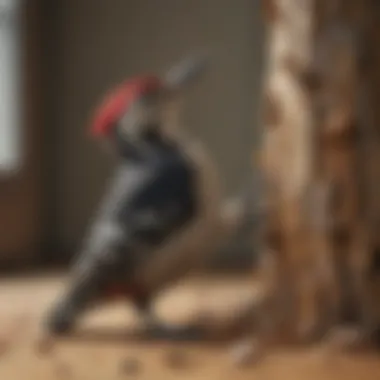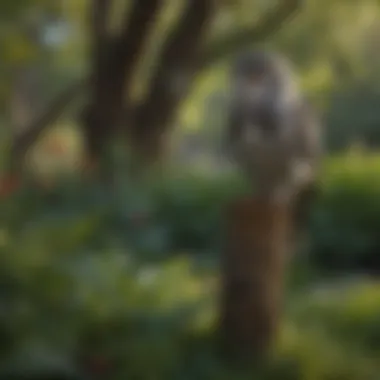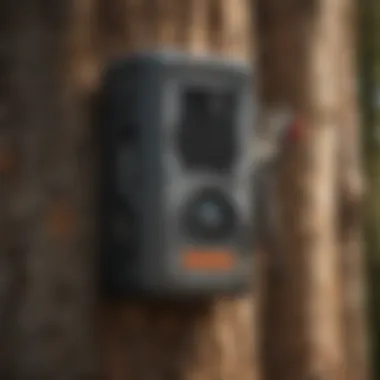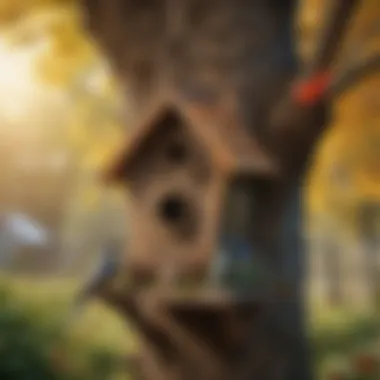Effective Strategies to Deter Woodpeckers from Home


Intro
Woodpeckers can be a fascinating part of nature, but when they choose to make a home on your property, the damage can be considerable. Understanding how to effectively deter these birds is essential. This article provides insights into why woodpeckers are drawn to certain locales, the potential harm they can cause, and the diverse methods available to protect your home in a respectful manner.
Understanding Pests
Definition of Pests
Pests are commonly defined as species that cause damage to crops, structures, or ecosystems. In the case of woodpeckers, their behavior of drilling holes in wood to find food or create nesting sites typically conflicts with human habitations.
Importance of Pest Identification
Identifying pests is crucial in determining effective strategies for control. Recognizing woodpecker species and understanding their behavior can assist homeowners in selecting appropriate deterrents. Certain species are protected, necessitating humane solutions that respect local wildlife laws.
Prevention Techniques
Home and Garden Preventative Measures
Prevention is the first line of defense against woodpeckers. Here are some strategies:
- Install bird deterrents: Items like reflective tape, old CDs, or metallic streamers can confuse woodpeckers and discourage them from approaching.
- Maintain your home: Regularly check for any signs of damage or weakness in wood structures. Addressing these issues can reduce the appeal of your home as a potential nesting site.
- Use hard materials: If you need to replace or repair siding, consider using materials like vinyl, which are less attractive to woodpeckers due to their density.
Seasonal Prevention Tips
Different seasons bring different challenges in deterring woodpeckers. Understand their behavior during these times:
- Spring: This is the nesting season. Ensuring that your wood surfaces are less appealing can prevent woodpeckers from drilling. Utilize noise deterrents like wind chimes.
- Winter: As food becomes scarce, woodpeckers may resort to pecking at homes. Providing alternative food sources, such as feeders filled with suet, can keep them occupied.
Eco-Friendly Pest Control Solutions
Overview of Sustainable Practices
Eco-friendly methods for pest control not only protect your property but also ensure that you are being responsible stewards of the environment. Techniques that involve minimal disruption to wildlife are essential.
Natural Remedies and Their Effectiveness
Some natural remedies are noted for their usefulness against woodpeckers:
- Cayenne pepper or chili powder: Sprinkling these substances may deter woodpeckers, as they do not like the taste. Apply them where woodpeckers frequently peck.
- Predator replicas: Using plastic owls or similar decoys may provide a visual deterrent.
The effectiveness of these natural remedies may vary. It is essential to monitor progress and adjust methods as needed.
Implementing these strategies can prove successful in dissuading woodpeckers from your home while promoting humane treatment of wildlife. Consider your endeavors carefully, respecting the balance between nature and homeownership.
Understanding Woodpeckers
Understanding woodpeckers is essential for homeowners who may encounter these birds. Their behavior and ecology play a critical role in how and why they become a nuisance. Woodpeckers can cause significant damage to homes, not only featuring extensive drilling but also compromising the structural integrity of buildings. By understanding their biology and habits, one can implement effective strategies to deter them from invading residential areas. This foundational knowledge sets the stage for identifying potential problems and developing proactive solutions to protect one's property.
Biology and Behavior of Woodpeckers
Woodpeckers belong to the family Picidae, characterized by their strong bills, zygodactyl feet, and long tongues, all adapted for foraging. They primarily rely on their sharp bills to drill into wood to extract insects, larvae, and sap. They are known for their distinct drumming sounds, which serve both communicational and territorial purposes. Woodpeckers possess excellent vision and hearing, which help them locate food. Their behavior varies among species; some are solitary, while others may appear in groups during breeding season. This knowledge is vital for creating a targeted strategy for deterring them.
Common Species of Woodpeckers
There are several common woodpecker species that homeowners might encounter. The Downy Woodpecker is one of the smallest, often found in both urban and rural settings. The larger Pileated Woodpecker is distinctive with its striking red crest and loud calls. Other species include the Hairy Woodpecker and the Northern Flicker. Each species has its unique characteristics, feeding habits, and nesting preferences, making it important for homeowners to identify the species present in their area. This identification can directly influence the choice of deterrent methods.
Ecological Importance of Woodpeckers
Woodpeckers serve vital functions within their ecosystems. They help control insect populations by eating larvae and other pests that can damage trees and plants. Additionally, the cavities they create in trees provide nesting sites for other birds and various small mammals. This behavior aids forest regeneration and biodiversity. Therefore, it is important for homeowners to strike a balance: deter woodpeckers from property while still recognizing their contributions to the local ecosystem. Understanding their ecological significance can enhance the approach to managing their presence in a humane manner.
Reasons for Woodpecker Intrusion
Understanding the reasons woodpeckers intrude upon your property is pivotal for developing effective strategies to deter them. These birds do not target homes out of malice; rather, their actions are rooted in survival instincts. By comprehensively examining their motivations, homeowners can implement tailored solutions that mitigate damage while respecting wildlife.


Searching for Food
Woodpeckers primarily seek insects or larvae hidden within the wood of trees and structures. They possess an advanced sense of hearing, allowing them to detect insects beneath the bark. Insects such as termites and wood-boring beetles are particularly attractive food sources. When woodpeckers make their way to wooden siding or eaves, it is typically in search of these pests.
To curb this intrusion, regular maintenance of structures is essential. Keeping wood surfaces sealed and free from moisture can deter both the woodpeckers and the damaging insects they pursue. Additionally, proper pest management on the property can indirectly reduce woodpecker visits by eliminating their food sources.
Nesting Behavior
During nesting season, which varies by species and region, woodpeckers seek secure locations to raise their young. They prefer to drill into soft wood or decaying trees because these materials are easier to excavate. Homes made of wood, especially those with structural vulnerabilities, may be targeted for their nesting sites.
To minimize this, it is important to inspect wooden structures for any weak spots. Fill any gaps or holes before nesting behavior begins. Using materials like metal flashing can discourage woodpeckers from choosing your home as a nesting site. By addressing potential nesting areas proactively, homeowners can reduce unwanted disturbances.
Territorial Marking
Woodpeckers are known for their drumming behavior, which serves as a method for marking territory and attracting mates. This drumming creates noise and leaves physical signs on the property. The sound of woodpeckers pecking against wooden surfaces, as well as the visible holes they make, can be a source of frustration for homeowners.
To address territorial marking, consider implementing visual deterrents such as reflective surfaces or hanging objects that move, which can create an unwelcoming environment for woodpeckers. Additionally, regular monitoring of woodpecker activity and being proactive about interventions can significantly reduce the impact of their territorial behaviors.
Identifying Damage Caused by Woodpeckers
Understanding the damage caused by woodpeckers is crucial for homeowners seeking to protect their property. Woodpecker activity can lead to significant structural damage. Recognizing the types of damage early can help in taking timely preventive measures. Moreover, knowing the signs of woodpecker activity is vital in assessing the extent of the problem before it escalates.
When woodpeckers drill into surfaces, they create holes that may compromise the integrity of walls, roofs, and eaves. Knowing what to look for will assist homeowners in deciding whether to employ simple deterrents or seek professional intervention.
Types of Damage to Property
Woodpeckers can cause various types of damage, which include:
- Holes and Cavities: These are most commonly found in wooden structures. The holes can allow moisture penetration, leading to wood rot and damage to insulation.
- Peeling Paint: Woodpeckers can remove paint from walls while searching for insects or establishing territory.
- Structural Compromise: If left unaddressed, woodpecker damage can weaken the structure of a home, risking its long-term stability.
- Noise Pollution: Frequent hammering can lead to disturbances for residents. The noise often indicates active feeding or nesting behavior.
It is important to document any findings which can aid in identifying severity. Photos are useful for reference when consulting with pest control or home repair professionals.
Signs of Woodpecker Activity
Recognizing signs of woodpecker presence can alert homeowners to potential damage. Observing these indicators is essential for effective management:
- Drilled Holes: Look for small holes, typically near areas where woodpeckers might search for food. These holes can be about the size of a dime.
- Wood Chips: Piles of wood shavings found around the base of trees or near structures can signal recent activity.
- Drumming Sounds: The characteristic drumming noise can be heard during the early morning, especially in spring. If persistent, it can signify an active nesting site.
- Behavior Observation: Frequently seeing woodpeckers on or around your home can indicate they are interested in nesting or feeding nearby.
"Identifying woodpecker activity early can save significant repair costs and prevent further damage to your property."
By staying vigilant and recognizing these signs, homeowners can take proactive steps to mitigate damage. Addressing woodpecker issues swiftly is essential for maintaining both the beauty and functionality of a home.
Assessment of the Situation
Understanding the situation at hand is crucial when dealing with woodpecker intrusions. A thorough assessment of the situation allows homeowners to identify the specific challenges posed by woodpeckers. This understanding will inform effective strategies for prevention and management, ultimately saving time, effort, and resources.
Evaluating your home's exposure to woodpeckers highlights the key areas of vulnerability. Knowing where the woodpeckers are causing damage can help in directing preventive measures more effectively. Additionally, recognizing the reasons behind woodpecker activity will guide homeowners in choosing the most suitable strategies to deter these birds.
Evaluating the Extent of Damage
Begin by carefully examining the areas of your house that may show signs of woodpecker-related damage. Look for chipping or pecking marks on wood siding and eaves. The severity of this damage can vary; sometimes, animals only leave superficial marks, while in other cases, they may create significant holes that can compromise the structural integrity of the home.
To assess the extent of the damage quantitatively, consider:
- Area Affected: Map out all locations exhibiting signs of damage.
- Type of Damage: Evaluate whether the damage is aesthetic or functional; assess its potential for leading to further issues, such as water intrusion or pest infestation.
- Response Time: Quick action can prevent further harm. If you delay, damage may escalate, making remediation more costly.
This assessment aids not just in solving immediate problems but also in preventing future issues.
Understanding the Design of Your Home
The architectural design of your home plays an important role in woodpecker activity. Certain designs attract these birds more than others, creating heightened risk. For instance, wooden siding texture, overhanging eaves, and the proximity to trees can increase the likelihood of woodpecker visits.
Key elements to examine include:
- Siding Material: Wooden siding is more appealing to woodpeckers. Assess if there are more durable alternatives available, such as fiber cement or vinyl.
- Architectural Features: Structures with decorative wood detailing may appeal to woodpeckers for pecking.
- Landscaping: Trees near the home can serve as perching spots. Trees with high insect populations may further entice woodpeckers to peck nearby structures.


By understanding your home’s design, you can identify areas that require targeted interventions. Implementing physical barriers in attractive spots and modifying the landscape can significantly reduce the frequency and severity of woodpecker incursions.
By linking these insights with effective deterrence strategies, you create a multi-faceted approach. This not only protects your property but promotes a harmonious coexistence with wildlife.
Preventive Measures to Deter Woodpeckers
Preventive measures are essential in managing woodpecker problems effectively. These strategies not only protect your property but also reduce the likelihood of future intrusions. The benefits of implementing these measures are clear. By addressing the underlying causes of woodpecker attraction, homeowners can create environments that discourage these birds from considering your home as their territory.
A comprehensive plan may involve a combination of physical barriers, visual and audio deterrents, and thoughtful landscaping adjustments. Each of these elements plays a critical role in creating a homeowner's fortress against unwanted woodpecker activity.
Physical Barriers
One of the most effective ways to deter woodpeckers is by installing physical barriers. These can range from simple solutions to more permanent fixtures. For instance, metal sheeting or bird netting can be affixed to areas where woodpeckers are known to peck. Using stainless steel mesh is effective due to its durability and resistance to weather.
Key points to consider when implementing physical barriers include:
- Placement: Barriers should cover areas that have sustained damage or are frequently targeted.
- Material Selection: Use robust materials that can withstand environmental elements.
- Installation: Ensure the installation is secure, with no gaps where birds can gain entry.
By effectively blocking access, these measures can significantly reduce woodpecker intrusion, offering both immediate and long-term protection.
Visual Deterrents
Visual deterrents serve to confuse or scare woodpeckers away from your property. These methods can be both creative and practical. Reflective surfaces are particularly effective; items such as aluminum foil, old CDs, or specialized reflective tape can create disturbances that disorient birds.
Some homeowners opt for more elaborate visual deterrents, such as:
- Predator Decoys: Owls or hawks can be set up around the property to emulate the presence of threats.
- Wind-Catchers: Objects that flutter in the breeze can increase visual disturbances, making the area less appealing.
It's important to reposition visual deterrents regularly to prevent woodpeckers from becoming accustomed to them.
Audio Deterrents
Sound-based deterrents can also be quite effective. Woodpeckers might avoid areas where they hear the sounds of predators or unsettling noises. Devices that emit these sounds can be placed strategically around your home.
Consider implementing the following audio deterrents:
- Ultrasonic Repellers: These devices emit sounds that are not audible to humans but can deter woodpeckers.
- Recorded Sounds of Predators: Playing sounds of predatory birds can create a sense of danger, convincing woodpeckers to seek safer environments.
Using audio deterrents in conjunction with other methods can enhance the likelihood of success.
Landscaping Adjustments
Your landscaping can influence woodpecker behavior significantly. By making certain adjustments, you can diminish the appeal of your property as a nesting site or food source.
Helpful landscaping tips include:
- Removing Old Trees: If a tree is infested with insects, it may invite woodpeckers. Remove such trees if possible or treat them accordingly.
- Reducing Available Insects: Keep gardens and lawns properly maintained to minimize insect populations.
- Choosing the Right Plants: Opt for flowering plants that do not attract wood-boring insects, thus making the area less appealing to woodpeckers.
By combining these strategies, homeowners can create a robust preventive framework that effectively deters woodpeckers. Ultimately, the goal is to create an environment that does not attract or sustain these birds, protecting both your property and local ecosystems.
Humane Deterrents and Solutions
Understanding humane deterrents and solutions is pivotal in addressing woodpecker issues. While woodpeckers are often seen as nuisances, it is essential to implement strategies that do not harm these birds or disrupt local ecosystems. These methods focus on redirecting woodpecker behavior without causing injury or distress. Moreover, they foster a respectful coexistence between humans and wildlife, aligning with principles of environmental conservation.
Using Repellent Sprays
Repellent sprays are an effective tool in discouraging woodpeckers from targeting specific areas. These sprays contain ingredients that are unpleasant to birds but safe for the environment. When applying these products, it is important to choose non-toxic options that do not contaminate surrounding plants or soil.
When using repellent sprays, apply them consistently to the affected areas. This could be on wooden surfaces or structures that woodpeckers frequent. Regular reapplication, especially after rain, is crucial for maintaining efficacy. Be sure to follow the manufacturer’s instructions for optimal results.
Managing Food Sources
Managing food sources is a fundamental strategy in deterring woodpeckers. These birds are primarily attracted by insects in wood, fruits, and feeders. By minimizing available food, homeowners can significantly reduce their presence.


- Inspecting the home: Regularly check for signs of insect infestations in wooden structures. Promptly addressing these issues will make your property less appealing.
- Securing trash: Ensure that garbage bins are tightly sealed. Leftover food scraps can attract woodpeckers along with other wildlife.
- Food for other birds: If you feed other birds, consider using feeders designed to minimize access for larger species like woodpeckers.
By controlling these food sources, homeowners can lessen the enticement for woodpeckers, ultimately reducing their activity around the property.
Creating Alternative Nesting Sites
Creating alternative nesting sites can also help deter woodpeckers from damaging your home. By providing suitable environments for nesting, woodpeckers may prefer these options over your structures.
- Birdhouses: Building or installing birdhouses specifically designed for woodpeckers can provide them a space to nest. Ensure these houses are safely positioned away from your home.
- Natural habitats: Promoting natural spaces with trees and shrubs can encourage woodpeckers to nest in these areas rather than in unwanted locations.
- Selecting proper materials: Use non-wooden materials for housing, as this can dissuade woodpeckers from pecking on your home’s structure.
These methods not only contribute to woodpecker management but also enrich the local biodiversity, offering benefits to various bird species.
Long-term Woodpecker Management
The sustained presence of woodpeckers around homes can lead to ongoing problems if not managed properly. Long-term management involves creating an environment that discourages woodpecker activity while maintaining a balance with nature. Understanding long-term woodpecker management is crucial for homeowners who want to protect their properties without resorting to harmful methods. This approach not only prevents damage but also supports the broader ecosystem, as woodpeckers play significant roles in controlling insect populations and promoting forest health.
Effective management requires a combination of strategies that can adapt to changing circumstances. Each home is unique, and what works in one area may not be as effective in another. Thus, tailoring strategies to specific locations and species of woodpeckers is key. This customized approach enhances the efficiency of efforts taken against woodpecker damage.
Ongoing Monitoring Strategies
One of the foundational elements of long-term woodpecker management is ongoing monitoring. Regularly assessing the situation helps identify new threats and changes in woodpecker behavior. Homeowners can employ several methods for effective monitoring:
- Visual Inspections: Routine checks of the property can reveal signs of woodpecker activity such as fresh holes, pecking noises, or wood debris. Keeping an eye on problem areas encourages timely responses.
- Noise Monitoring: Installing noise detection devices can help track when woodpeckers are most active. This information can guide the timing of deterrent measures.
- Camera Systems: Setting up cameras can provide real-time monitoring of woodpecker activity. This technology helps in understanding patterns and identifying specific species visiting the area.
By maintaining vigilance, homeowners can address problems before they escalate, thereby safeguarding their homes more effectively.
Community Involvement and Education
Community involvement is an integral part of managing woodpecker populations. Collaborating with neighbors not only amplifies individual efforts but can introduce communal solutions. Educating residents about woodpecker behavior and humane deterrent methods is equally important. Here are some ways to encourage community engagement:
- Workshops and Seminars: Organizing educational sessions can help demystify woodpecker habits. Share effective strategies like using physical barriers and exploring ecological understanding.
- Local Wildlife Groups: Partner with local wildlife organizations to foster a community-wide commitment to woodpecker management. These groups often possess valuable expertise and resources.
- Sharing Information Online: Establish local online platforms where community members can share experiences and solutions related to woodpecker challenges. This not only supports individuals but builds a larger network of awareness.
Incorporating community measures enriches the overall strategy against woodpecker damage. It fosters an environment where responsible management of wildlife becomes a shared goal, ultimately leading to a positive impact on both nature and human dwellings.
When to Seek Professional Help
In certain circumstances, dealing with woodpeckers can become overwhelming for homeowners. Recognizing when to seek professional help is essential for effective and humane solutions to protect your property. This section outlines critical situations that warrant professional intervention and provides insights on choosing the right pest control service.
Identifying Critical Situations
Some situations require more than simple preventative measures. If woodpeckers cause extensive damage to your home, it may be more efficient to consult with a specialist. Signs of critical situations include:
- Severe Structural Damage: When woodpeckers bore holes into the siding or frame, impacting the integrity of your home.
- Repeated Attacks: Chronic disturbances that occur regularly, indicating a persistent problem.
- Health Risks: Presence of bird droppings near entrances may lead to health risks for the household.
These indicators can suggest that DIY methods are insufficient. Professional wildlife control experts can assess the damage and provide the necessary solutions.
Choosing the Right Pest Control Service
When selecting a pest control service for woodpecker management, do your research. Here are aspects to consider:
- Experience and Expertise: Look for companies that specialize in bird control. They will have the appropriate knowledge to handle woodpecker issues.
- Humane Methods: Ensure that the service prioritizes humane techniques for deterring woodpeckers. This aligns with the goal of respecting wildlife while protecting your property.
- Reputation: Read reviews and seek recommendations from others. A trusted service typically receives positive feedback from satisfied clients.
- License and Insurance: Confirm that the service holds the relevant licenses and insurance. This protects both you and the technicians during the process.
"Ignoring the signs can lead to more significant problems. Timely intervention is key to managing woodpecker issues effectively."
Ultimately, approach pest control with careful consideration. Assess the situation objectively before making decisions. By doing this, the solution can be both efficient and environmentally respectful.
Finale
Recap of Effective Strategies
To summarize, several key approaches can successfully protect your property from woodpecker damage:
- Physical Barriers: Installing mesh or metal sheathing can prevent access to vulnerable areas.
- Visual Deterrents: Items like reflective tape, plastic owls, or predator decoys can create a hostile environment.
- Audio Deterrents: Sound devices that imitate natural predators or disruptive noises may disturb woodpeckers and encourage them to move elsewhere.
- Landscaping Adjustments: Strategic landscaping can reduce access to food sources, encouraging woodpeckers to seek alternate habitats.
- Repellent Sprays: Using humane and safe repellent products can be effective in keeping woodpeckers at bay.
- Alternative Nesting Sites: Creating designated areas that are less intrusive can redirect nesting.
This variety of strategies allows for flexibility based on individual situations and preferences.
Encouraging a Balanced Ecosystem
Maintaining a balanced ecosystem is essential. While it is important to protect your home, it is equally critical to respect wildlife. Woodpeckers play significant roles in their habitats, such as controlling insect populations and creating cavities that many other species use for nesting. By implementing humane strategies to deter them, homeowners can achieve a middle ground where both property and wildlife can coexist.
Engaging in community education and involvement is one way to promote understanding about woodpeckers and their ecological contributions. Sharing knowledge about effective management practices can help foster a more harmonious relationship between humans and these birds.



